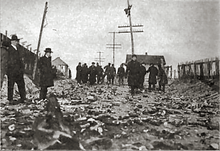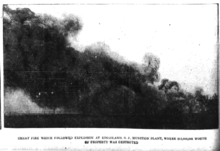Kingsland explosion

The Kingsland explosion was an incident that took place during World War I at a munitions factory in Lyndhurst, New Jersey, United States, on January 11, 1917. An arbitration commission in 1931 determined that, "In the Kingsland Case the Commission finds upon the evidence that the fire was not caused by any German agent."[1]
The U.S. was officially neutral, but American and Canadian companies supplied goods to the Allies giving an incentive for acts of sabotage on American soil. The acts were largely symbolic rather than having any real effect on the war supply efforts and only two acts were of even marginal importance, given the scale of the conflict. It is generally accepted that the acts of sabotage were carried out by the Germans although Germany never formally admitted responsibility. The Kingsland explosion was suspected in the popular media of being German sabotage, but there was no evidence implicating any German official.
The Canadian Car and Foundry Company, based in Montreal, had signed large contracts with Russia and Britain for delivery of ammunition. An enormous factory was constructed in the New Jersey Meadowlands, which was then referred to as Kingsland. The company executives decided not to take any chances with security for their plant. They constructed a six-foot fence around the plant and hired security guards to conduct 24-hour patrols around the perimeter and to screen each worker as they entered the plant. It was located on the site of Lyndhurst's present industrial park. A brick stack, believed to be the remaining part of the Foundry, is located in the area bounded by Valley Brook Avenue, Polito Avenue, and the office buildings on Wall Street West.
On January 11, 1917, a fire started in Building 30 of the Canadian Car and Foundry Company at Kingsland in Bergen County, New Jersey. In 4 hours, probably 500,000 pieces of 76 mm (3") -high explosive shells were discharged.[2] The entire plant was destroyed.[3] It was said to have been a spectacle more magnificent than the nearby 1916 explosion at Black Tom. From office buildings and tall apartments, people in New York City watched with amazement.
The building
In March 1916, World War I was in progress. Although the United States had not yet entered the war, the country was assisting its allies with war supplies. Munitions, including shells, shell cases, shrapnel, and powder were shipped to Kingsland from over 100 different factories. At the foundry they were assembled for shipment to Russia. Producing 3 million shells per month, the factory was a worthy objective for German saboteurs.
Building 30 was used exclusively for cleaning out shells; it contained 48 workbenches. On the bench in front of each employee was a pan of gasoline and a small rotating machine operated by a belt. The cleaning process included several steps:
- The shells were dusted with a brush
- A cloth, moistened in the pan of gasoline, was wrapped around a foot-long piece of wood
- The shell was placed in the rotating machine and the wood was inserted into the shell as it turned
- A dry cloth was wrapped around the stick and the shell was dried in a similar manner.
The suspected sabotage
Rumor had it that a group of saboteurs operated under the direction of Frederick Hinsch. He recruited a German national, Curt Thummel, who changed his name to Charles Thorne. Hinsch instructed Thorne to obtain employment at the factory. Thorne was hired as assistant employment manager. In this position he facilitated the hiring of several operatives sent by Hinsch to infiltrate the factory. One of those employees supposedly was Theodore Wozniak.
After the Kingsland plant was completely destroyed, police and federal investigators uncovered the source of the fire. It started at Wozniak's workbench in Building 30.[2]
Other workmen alleged that the fire began in front of Wozniak's wooden roller. One of the company directors, Mr. Cahan, remarked about Wozniak's nervous behavior and contradictions during an interview about the incident. Wozniak, who admitted that he had served time as a draftee in the Austrian Army, was told by Mr. Cahan that he would be needed in New York as part of the investigation into the fire. Wozniak, who lived at the Russian Immigrant House on Third Street in New York City, eluded the detectives who were watching him and disappeared.
The heroine

Kingsland resident Theresa Louise "Tessie" McNamara, who operated the company switchboard, was credited with saving 1,400 lives; Despite the fire McNamara stayed at the switchboard. She plugged in each of the buildings and shouted the warning, "Get out or go up!"[2] No one was killed in the fire as a result of her announcements. Fleeing workers were able to cross the frozen Hackensack River or run up Valley Brook Avenue to safety. Some of those who crossed the Hackensack River made their way to the buildings on Snake Hill.
The National Special Aid Society later presented McNamara with a check to honor her for her bravery.
The Lyndhurst Historical Society has created a vest pocket park dedicated to McNamara's memory. The park is located on Clay Avenue, between Valley Brook Avenue and Wall Street West. The brick stack can be seen from this park.
Terror ruled Snake Hill
There were Hudson County penal and charitable institutions at Snake Hill, in Secaucus. The Almshouse, Penitentiary, and Hospital for the Insane, Contagious Diseases Hospital, and Tuberculosis Sanitarium, were all grouped on the north side of Snake Hill. When the fire and ensuing explosions started, the residents of Snake Hill began to panic, fearing the world was coming to an end. From the windows they could see what the warden later described as a big display of fireworks. As the 900+ inmates of the asylum grew more panicked, the superintendent, Dr. George W. King, and Dr. James Meehan, chairman of the Hospital committee figured a way to calm the residents. Dr. Meehan hurried to the hospital with supplies of ice cream, fruits and candies. The inmates were assembled in the lecture hall and they were told that the European War had ended and the explosions were detonations of big guns to celebrate the event.
Aftermath
A reparations case was launched by John J. McCloy against Germany in 1934 that dragged on for many years and was finally settled in the 1950s. Germany never admitted guilt, but paid $50 million in reparations to the United States.[4]
See also
References
- ↑ Mixed Claims Commission-United States And Germany, The American Journal of International Law (1931) , Volume 25 p 147 in JSTOR
- 1 2 3 "The Kingsland Explosion". Lyndhurst Historical Society. n.d. Retrieved May 11, 2010.
- ↑ "Kingsland and Haskell Disasters". Safety Engineering. 33 (1): 28–32. January 1917.
- ↑ Goodnight, L (2003-07-16). "The blast heard halfway 'round the world". The Record. via HighBeam Research. Retrieved 2012-04-16. (subscription required)
External links
- "Kingland Explosion". Lyndhurst Historical Society. Retrieved May 12, 2017.
- "100 years ago today the Germans burned down a Trenton factory, historians believe". nj.com. January 18, 2015. Retrieved May 12, 2017.